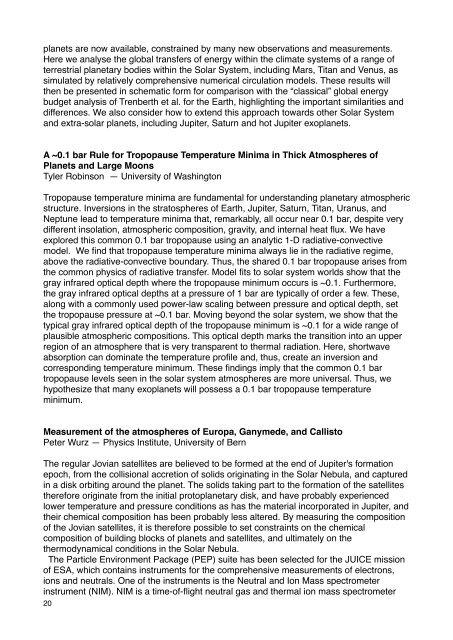Exoclimes_Conference_booklet1
Exoclimes_Conference_booklet1
Exoclimes_Conference_booklet1
You also want an ePaper? Increase the reach of your titles
YUMPU automatically turns print PDFs into web optimized ePapers that Google loves.
planets are now available, constrained by many new observations and measurements.<br />
Here we analyse the global transfers of energy within the climate systems of a range of<br />
terrestrial planetary bodies within the Solar System, including Mars, Titan and Venus, as<br />
simulated by relatively comprehensive numerical circulation models. These results will<br />
then be presented in schematic form for comparison with the “classical” global energy<br />
budget analysis of Trenberth et al. for the Earth, highlighting the important similarities and<br />
differences. We also consider how to extend this approach towards other Solar System<br />
and extra-solar planets, including Jupiter, Saturn and hot Jupiter exoplanets.<br />
A ~0.1 bar Rule for Tropopause Temperature Minima in Thick Atmospheres of<br />
Planets and Large Moons<br />
Tyler Robinson — University of Washington<br />
Tropopause temperature minima are fundamental for understanding planetary atmospheric<br />
structure. Inversions in the stratospheres of Earth, Jupiter, Saturn, Titan, Uranus, and<br />
Neptune lead to temperature minima that, remarkably, all occur near 0.1 bar, despite very<br />
different insolation, atmospheric composition, gravity, and internal heat flux. We have<br />
explored this common 0.1 bar tropopause using an analytic 1-D radiative-convective<br />
model. We find that tropopause temperature minima always lie in the radiative regime,<br />
above the radiative-convective boundary. Thus, the shared 0.1 bar tropopause arises from<br />
the common physics of radiative transfer. Model fits to solar system worlds show that the<br />
gray infrared optical depth where the tropopause minimum occurs is ~0.1. Furthermore,<br />
the gray infrared optical depths at a pressure of 1 bar are typically of order a few. These,<br />
along with a commonly used power-law scaling between pressure and optical depth, set<br />
the tropopause pressure at ~0.1 bar. Moving beyond the solar system, we show that the<br />
typical gray infrared optical depth of the tropopause minimum is ~0.1 for a wide range of<br />
plausible atmospheric compositions. This optical depth marks the transition into an upper<br />
region of an atmosphere that is very transparent to thermal radiation. Here, shortwave<br />
absorption can dominate the temperature profile and, thus, create an inversion and<br />
corresponding temperature minimum. These findings imply that the common 0.1 bar<br />
tropopause levels seen in the solar system atmospheres are more universal. Thus, we<br />
hypothesize that many exoplanets will possess a 0.1 bar tropopause temperature<br />
minimum.<br />
Measurement of the atmospheres of Europa, Ganymede, and Callisto<br />
Peter Wurz — Physics Institute, University of Bern!<br />
The regular Jovian satellites are believed to be formed at the end of Jupiter's formation<br />
epoch, from the collisional accretion of solids originating in the Solar Nebula, and captured<br />
in a disk orbiting around the planet. The solids taking part to the formation of the satellites<br />
therefore originate from the initial protoplanetary disk, and have probably experienced<br />
lower temperature and pressure conditions as has the material incorporated in Jupiter, and<br />
their chemical composition has been probably less altered. By measuring the composition<br />
of the Jovian satellites, it is therefore possible to set constraints on the chemical<br />
composition of building blocks of planets and satellites, and ultimately on the<br />
thermodynamical conditions in the Solar Nebula.<br />
The Particle Environment Package (PEP) suite has been selected for the JUICE mission<br />
of ESA, which contains instruments for the comprehensive measurements of electrons,<br />
ions and neutrals. One of the instruments is the Neutral and Ion Mass spectrometer<br />
instrument (NIM). NIM is a time-of-flight neutral gas and thermal ion mass spectrometer<br />
20


